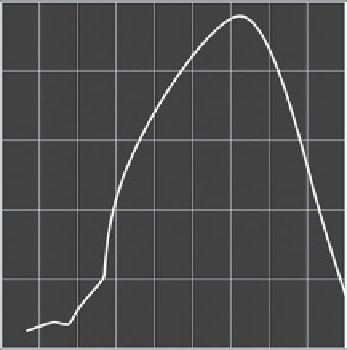Geoscience Reference
In-Depth Information
(Typ.
T
a
= 25°C)
0.25
0.20
0.15
0.10
0.05
0
100
200
300
700
WAVELENGTH (nm)
400
500
600
800
900
1000
Figure 5.16. Radiant sensitivity of a large area silicon photodiode detector.
5.4.6 Measurement Systems: Data Acquisition Electronics and Software
The output signal from the detector must be monitored, stored, and analyzed to make a
spectroscopic measurement. As such, the signal-processing and readout system is extremely
important to the overall performance of the system. The particular type of signal processing
depends on the form of the output signal, the noise sources expected, and the signal level
itself. The signal-processing step can perform many conversions such as current-to-volt-
age, analog-to-digital conversion, amplification, or some mathematical operation designed
to improve the measurement of SNR.
The outputs of most detectors are used in the analog mode. The exception to this is the
photomultiplier, which may be also be used in the photon-counting mode. Nearly all meas-
urements are made by using an analog-to-digital converter (ADC) to convert the analog
output of a detector to the digital domain for future processing, analysis, and display. Even
in digital measurements some conditioning, such as filtering or amplifying the analog sig-
nal, is usually necessary to make it suitable for recording by the ADC. In photon counting
systems, the recorded signal is the number of pulses observed or counted. Photon counting
is particularly useful in applications where the signal irradiance is relatively low, such as
photoluminescence measurements.
5.4.7 Data Collection, Display, and Analysis Software
At the most basic level, spectroscopic software must allow for reliable, efficient collec-
tion and storage of data with minimal sacrifice of hardware performance. As spectroscopy
increases in complexity and importance in everyday activities, software is becoming more

